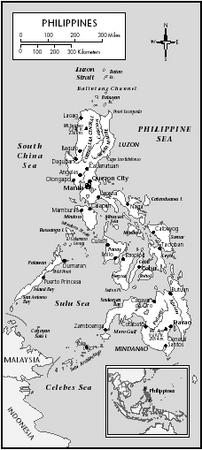The Republic of the Philippines was named the Filipinas to honor King Philip the Second of Spain in 1543. The Philippine Islands was the name used before independence.
Location and Geography.
The Republic of the Philippines, a nation of 7,107 islands with a total area of 111,830 square miles (307,055 square kilometers), is located on the Pacific Rim of Southeast Asia. Two thousand of its islands are inhabited. Luzon, the largest island with one-third of the land and half the population, is in the north. Mindanao, the second largest island, is in the south. The Philippines are 1,152 miles (1,854 kilometers) long from north to south. The width is 688 miles (1,107 kilometers). There are no land boundaries; the country is bordered on the west by the South China Sea, on the east by the Philippine Sea, on the south by the Celebes Sea, and on the north by the Luzon Strait, which separates the country from its nearest neighbor, Taiwan. The closest nations to the south are Malaysia and Indonesia. Vietnam and China are the nearest neighbors on the mainland of Asia.
The islands are volcanic in origin. Mount Mayon in southern Luzon erupted in 2000. Mount Pinatubo in central Luzon erupted in 1991 and 1992. Both eruptions caused destruction of villages and farms and displaced thousands of people from their tribal homelands. Because the country is volcanic, the small islands have a mountainous center with coastal plains. Luzon has a broad central valley in the northern provinces along the Cagayan River and plains in the midlands near Manila, the capital. Mindanao and Panay also have central plains. Northern Luzon has two major mountain ranges: the Sierra Madres on the eastern coast and the Cordilleras in the center. The highest peak is Mount Apo in Mindanao at 9,689 feet (2,954 meters).
The weather is hot because of the country's closeness to the equator. The temperatures are constant except during typhoons. The dry season is from January to June; the wet season with monsoon rains is from July to December. Temperatures are cooler in November through January, dropping below 30 degrees Celsius (85 degrees Fahrenheit). The summer months of April and May have temperatures in excess of 39 degrees Celsius (100 degrees Fahrenheit). Typhoons occur from June through November.
Demography.
The estimated population in July 2000 was eighty-one million. The average life expectancy is sixty-seven years. Four percent of the population is over age sixty-five. The most populous area is Metropolitan Manila, where eight million to ten million people live.
Linguistic Affiliation.
The official languages are Filipino, which is based on Tagalog with words from other native languages, and English. Since only 55 percent of residents speak Filipino fluently, English is used in colleges, universities, the courts, and the government. The country's seventy to eighty dialects are derived from Malay languages. Three dialects are of national importance: Cebuano in the southern islands, Ilocano in the north, and Tagalog, the language of the National Capital Region. When Tagalog was chosen as the basis for a national language, Cebuanos refused to use Filipino. "Taglish," a mixture of Filipino and English, is becoming a standard language. Filipinos are proud that their country has the third largest number of English speakers in the world. Filipino English includes many Australian and British terms. It is a formal language that includes words no longer commonly used in American English. Spanish was taught as a compulsory language until 1968 but is seldom used today. Spanish numbers and some Spanish words are included in the dialects.

The dependence on English causes concern, but since Filipino does not have words for scientific or technological terms, English is likely to remain in common use.
Symbolism.
National symbols have been emphasized since independence to create a sense of nationhood. The Philippine eagle, the second largest eagle in the world, is the national bird. Doctor Jose Rizal is the national hero. Rizal streets and statues of Rizal are found in most towns and cities. Several municipalities are named for Rizal. The most prominent symbol is the flag, which has a blue horizontal band, a red horizontal band, and a white field. The flag is flown with the blue band at the top in times of peace and the red band at the top in times of war. Flag ceremonies take place once a week at all governmental offices. Schools have a flag ceremony each morning. All traffic stops while the flag is being honored. The national anthem is sung, a national pledge is recited in Filipino, and the provincial hymn is sung.


